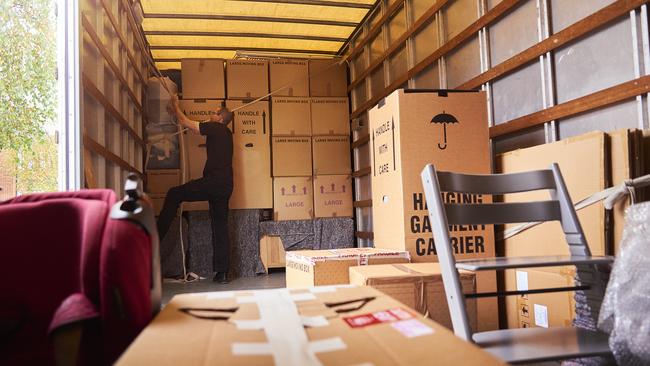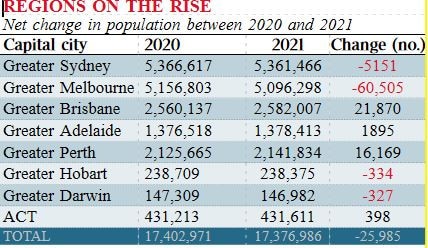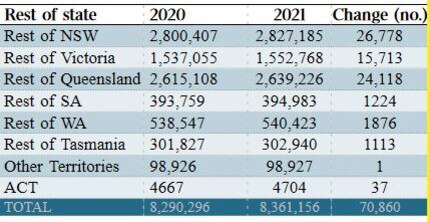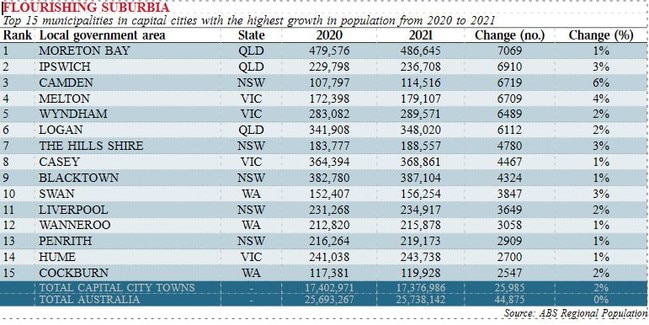On the move: Reshuffling the Australian population
Covid has boosted regional areas, making them demographic winners during the pandemic.

For the 20 years leading up to the pandemic, Australia was growing rapidly from a demographic point of view with its population increasing every year. But Covid has set back Australia’s strong rate of growth and some capital cities are now actually losing population.
These developments have resulted in a dramatic shift in population movements across Australia.
The ABS Regional Population data shows population estimates across 541 Australian municipalities for every fiscal year from 2001. This data is released annually; the latest data was released on March 29. This dataset reveals how the pandemic has created winners and losers across Australia in terms of population movements.
Regions on the rise
Australia’s population grew by 45,000 during the 2020/21 fiscal year. It compares with growth of 328,000 over the previous fiscal year.
Even though the level of net growth for Australia during 2020/21 was the lowest over the last 20 years, the minutiae of the municipal data demonstrate how many of the (lifestyle) regions flourished during the pandemic.

The population of regional Australia (ie excludes all capital cities) grew by 70,900 during 2020/21; this is in contrast to a decline of 26,000 for all capital cities combined.
Regional New South Wales (up 26,800) and regional Queensland (24,100) led the way in terms of population growth over 2020/21, with regional Victoria (15,700) also increasing despite (or because of) the harsh lockdown restrictions that applied to that state.

In contrast, the population of Greater Melbourne declined by 6500 and Greater Sydney decreased by 5200 during this pandemic year. Although the population increased in Brisbane, Perth, Adelaide and Canberra, this growth was offset by the decline in Melbourne and Sydney.
There were even net losses in the smaller capitals of Hobart and Darwin revealing, perhaps, the extent to which these cities are linked into places like Melbourne and Canberra.
Regional winners
For the last 10 years, the Australian population surged ahead in leaps of 300,000 and-more per year. Generally, the inner city attracted population from the regions. Students and immigrants in particular were also drawn to the hipped-up culture of the inner city.
Then along came Covid. The border was shut throughout the 2021 fiscal year. More local residents left Australia than expat Aussies returned. International student and immigrant numbers plummeted. This, along with the internal movement of population from the cities to the regions, boosted the regions making them demographic winners during the pandemic.
The rise of the work from home movement played a big part in fuelling this movement. For the first time young Australians (as opposed to pre-retirees) could move to the regions with their job! As a result, many regions benefited from an influx of youth, energy and skills.
Moving to the regions during the pandemic seemed like an attractive option.
Bigger living spaces, cheaper rent when compared with the inner city, cheaper property prices and some regions even offered less severe lockdown restrictions.

Working from home and flexible work options allowed people to move further from the city. This changed the dynamics of the property market and boosted local businesses in the regions. Out of the 541 local government areas across Australia, 307 or 57 per cent recorded positive growth in population during 2020/21.
Amongst these “growing” municipalities, 247 were located outside capital cities. In this year about 80 per cent of Australia’s population growth was concentrated in the regions.
Let’s take a closer look at municipalities recording the highest population growth in the 2021 fiscal year that are outside the capital cities.
The City of the Gold Coast had the highest growth (8000) followed by the Sunshine Coast (7000) and Greater Geelong (5000).
Victoria’s Ballarat, Baw Baw, Mitchell and Surf Coast are among the top 15 regional municipalities that recorded a surge in population.
Similarly in NSW, municipalities in the Hunter Region such as Maitland, Lake Macquarie and Cessnock recorded strong growth in population.
Based on this evidence it is apparent that regional winners are either major regional centres or are lifestyle towns located just beyond the edge of the capital city or that comprise classic treechange or sea-change communities.
Clearly, and despite Covid, the Australian penchant for lifestyle remains unchanged by the pandemic.
Outer suburbs boom as the inner-city contracts
Now let us change the focus by reviewing the demographic performance of municipalities located within capital cities.
Within the metropolitan area it is the outer suburbs that exhibited the highest growth in population during 2020/21, confirming that traditional suburbia remains central to the Australian way of life.
Brisbane’s Moreton Bay leads the pack with a net increase of 7000 residents followed by Ipswich which added 6900 more people (see graphic 3).
In Sydney, the outer municipality of Camden recorded the highest growth with 6700, followed by The Hills Shire (4700) and Blacktown (4300).

Melton (6700) and Wyndham (6500) were the top places for growth in Melbourne.
The imposition of lockdown restrictions and the lack of an international student inflow had an immediate impact on the population base (and the demand for rental accommodation) of inner-city municipalities across Australia.
In Victoria, the City of Melbourne (includes the CBD) had the greatest decline in population (-14,000) followed by university precincts like Monash (-7000), Boroondara (-6000) and inner-city municipalities like Port Philip (-4000) and Yarra (-3500).
We can observe a similar pattern in NSW with the City of Sydney (includes CBD) losing 6000 residents, followed by (international) student and immigrant municipalities such as Randwick, Fairfield and Cumberland each losing 3000 residents in this year.
The only way there could have been any significant population growth across Australian municipalities during the 2020/21 pandemic year, when the national growth rate dropped to 45,000, is from internal migration: Australians choosing to leave one municipality in preference for another. And in some ways this “Covid year” has revealed the core lifestyle values and preferences of the Australian people.
By comparing the growth in population between the 2019/20 financial year and the 2020/21 financial year, we can track the shift in population movements.
Of Australia’s 541 municipalities, 123 recorded a lesser annual growth during 2020/21 as compared with 2019/20.
For example, Melbourne’s City of Maroondah lost 13,700 people in the year ending June 2021, but this municipality grew by 4600 during the year prior to the pandemic. (Maroondah is a hotspot for students and Chinese immigrants.)
Similarly, Victoria’s Shire of Moira lost 6800 residents over the year to June 2021 (mostly seasonal workers and backpackers) but grew by 1900 the previous year.
These Victorian communities are followed by the City of Sydney which lost 6400 residents over the year to June 2021 but had gained 2700 residents the previous year.
Outlook
The recently released population estimates by local government area reveal the first decline in population for capital cities ever recorded by the ABS.
The gears have shifted; the pandemic has caused the Australian population to reshuffle during these extraordinary times.
It is natural to conclude that modern day Australians simply prefer lifestyle suburbs and selected regional centres over the congested inner city.
However, the bigger question is whether the extraordinary population movements recorded across 2020/21 will be retained or even reversed during the “recovery years”.
In either case it is evident that regional centres and lifestyle towns are growing strongly and so will require investment in social and hard infrastructure during the 2020s.
This investment will create more employment opportunities, and which then translates into greater demand for residential and other forms of property. In some ways the coming of the coronavirus has triggered an even greater engagement by lifestyle-seeking Australians with the regions and has alleviated some of the congestion of inner-city living.
In either case the outlook is for recovery during 2022 with rising demand for property, lifestyle and the Aussie way of life.
Hari Hara Priya Kannan is data scientist with The Demographics Group.



To join the conversation, please log in. Don't have an account? Register
Join the conversation, you are commenting as Logout